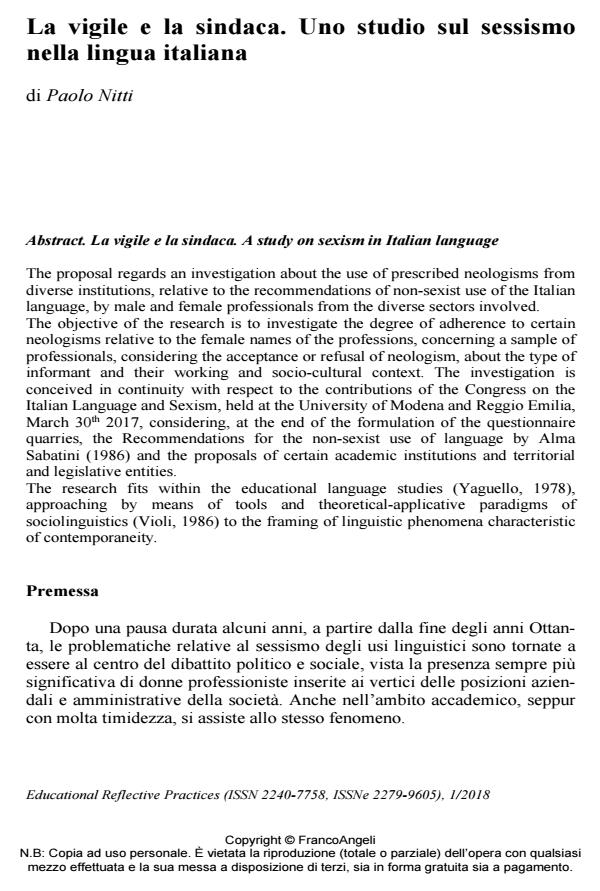Ragioni artistiche della parità e delle differenze di genere
Titolo Rivista EDUCATIONAL REFLECTIVE PRACTICES
Autori/Curatori Gianni Nuti
Anno di pubblicazione 2018 Fascicolo 2018/1
Lingua Italiano Numero pagine 14 P. 108-121 Dimensione file 182 KB
DOI 10.3280/ERP2018-001007
Il DOI è il codice a barre della proprietà intellettuale: per saperne di più
clicca qui
Qui sotto puoi vedere in anteprima la prima pagina di questo articolo.
Se questo articolo ti interessa, lo puoi acquistare (e scaricare in formato pdf) seguendo le facili indicazioni per acquistare il download credit. Acquista Download Credits per scaricare questo Articolo in formato PDF

FrancoAngeli è membro della Publishers International Linking Association, Inc (PILA)associazione indipendente e non profit per facilitare (attraverso i servizi tecnologici implementati da CrossRef.org) l’accesso degli studiosi ai contenuti digitali nelle pubblicazioni professionali e scientifiche
To promote a gender culture that contrasts stereotypes and discriminations it is necessary to acknowledge the need, on the part of everyone, to cultivate two feelings only apparently in antithesis and in reality poles of a single dynamic vector: the sense of belonging on one side and that of distinction, separation from the other. Art escapes from stereotypy, is incompatible with closed and preconceived systems, becomes animated with a free spirit, destabilizing, nourishes divergent thought and therefore, also in the culture of gender, fosters the opening of the mind towards authentic manifestations of one’s identity and at the same time promotes experiences of unity, possibility for many people to identify themselves in a single corpus of aesthetic signs. The contribution brings together some of the possibilities to deepen, under the educational profile, the theme of gender differences through theater, dance, literature, cinema, music, anchoring this excursus to the ontogenetic and phylogenetic roots of human beings
- Baumeister R.F., Leary M.R. (1995). The need to belong: Desire for interpersonal attachments as a fundamental human motivation. Psychological Bulletin, 117: 497-529.
- Boetti Sauzeau A. M. (1979). Arte femminista e arte femminile. In: AA.VV., Lessico Politico delle Donne. Cinema, letteratura, arti visive. Milano: Gulliver, pp. 133-183.
- Butler J. (1990). Gender trouble and the subversion of identity. New York and London: Routledge.
- Fiaschini F. (2007). L’“incessabile agitazione”: Giovan Battista Andreini tra professione teatrale, cultura letteraria e religione (Vol. 1). Pisa: Giardini editori e stampatori.
- Joel D., Berman Z., Tavor I., Wexler N., Gaber O., Stein Y., & Liem F. (2015). Sex beyond the genitalia: The human brain mosaic. Proceedings of the National Academy of Sciences, 112(50): 15468-15473.
- De Martino E. (2004). Sud e magia (1959). Milano: Feltrinelli.
- During J.(2014). Musica ed estasi. L’ascolto mistico nella tradizione Sufi. Roma: Squilibri Editore.
- Gadda C.E. (1993). Scritti vari e postumi. (a cura di) A. Silvestri, C. Vedla, D. Isella, P. Italia, G. Pinotti. Milano: Garzanti, pp. 862-63.
- Garavaglia V. (2007). Teatro, educazione, società. Novara: De Agostini scuola.
- Guimarães Rosa J. (1970). Grande Sertão: Veredas. Milano: Feltrinelli.
- Malloch S., & Trevarthen C. (Eds). (2009). Communicative Musicality: Exploring the basis of human companionship. Oxford: Oxford University Press.
- Mapelli B. (2016), L’androgino tra noi. Roma: Ediesse.
- Martin P. Y. (2003). “Said and done” versus “saying and doing” gendering practices, practicing gender at work. Gender & society, 17(3): 342-366.
- Miall D., Dissanayake E. (2003). The poetics of babytalk. Human Nature 14(4): 337-364.
- Musil R. (2005). L’ uomo senza qualità. Torino: Einaudi.
- Nuti G. (2005). Musica delle Cose Prime. Torino: Sistema Musica.
- Papoušek H., & Papoušek M. (2002). Intuitive parenting. Handbook of Parenting, Vol. 2 Biology and Ecology of Parenting, 182.
- Rouget G.(1986). Musica e trance. I rapporti fra la musica e i fenomeni di possessione. Torino: Einaudi, pp. 238-239.
- Schaffer H. R. (1996). Social development. Blackwell Publishing.
- Scheper‐Hughes N. (1985). Culture, scarcity, and maternal thinking: Maternal detachment and infant survival in a Brazilian shantytown. Ethos, 13(4): 291-317.
Gianni Nuti, Ragioni artistiche della parità e delle differenze di genere in "EDUCATIONAL REFLECTIVE PRACTICES" 1/2018, pp 108-121, DOI: 10.3280/ERP2018-001007